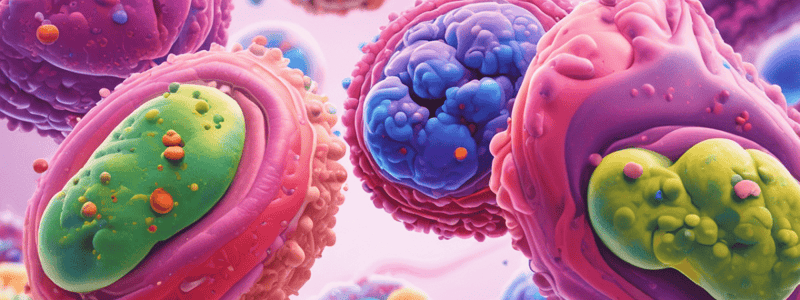Podcast
Questions and Answers
Which type of STD can typically be treated with antibiotics?
Which type of STD can typically be treated with antibiotics?
- Gonorrhea (correct)
- HIV/AIDS
- Mycoplasma genitalium (Mgen)
- Syphilis
Which STD can cause painful blisters around the genitals?
Which STD can cause painful blisters around the genitals?
- Genital warts
- Trichomoniasis
- Herpes simplex virus (HSV) (correct)
- Hepatitis B
Which viral STD can result in lifelong infections?
Which viral STD can result in lifelong infections?
- Chlamydia
- HIV/AIDS (correct)
- Syphilis
- Gonorrhea
How is Human papillomavirus (HPV) primarily spread?
How is Human papillomavirus (HPV) primarily spread?
Which bacterial STD commonly affects the genitals, rectum, and throat with minimal or no symptoms?
Which bacterial STD commonly affects the genitals, rectum, and throat with minimal or no symptoms?
Which STD is transmitted through parasites and can cause unusual genital discharge?
Which STD is transmitted through parasites and can cause unusual genital discharge?
What is a long-term bacterial infection that can have various stages with symptoms like sores, fever, and joint pain?
What is a long-term bacterial infection that can have various stages with symptoms like sores, fever, and joint pain?
Can some STDs be transmitted through close physical contact other than sexual activities?
Can some STDs be transmitted through close physical contact other than sexual activities?
Which bacterial STD is caused by the bacteria Mycoplasma genitalium and can lead to complications if untreated?
Which bacterial STD is caused by the bacteria Mycoplasma genitalium and can lead to complications if untreated?
Which STD can lead to several types of cancer and is known for being transmitted through skin-to-skin contact?
Which STD can lead to several types of cancer and is known for being transmitted through skin-to-skin contact?
Among the listed STDs, which one is not caused by bacteria?
Among the listed STDs, which one is not caused by bacteria?
What preventive measures are recommended to help prevent the transmission of STDs?
What preventive measures are recommended to help prevent the transmission of STDs?
Study Notes
Types of Sexually Transmitted Diseases (STDs)
Sexually transmitted diseases (STDs) encompass a wide array of bacterial, viral, and parasitic infections that can be acquired through sexual contact, including vaginal, oral, and anal sex, as well as other forms of intimate physical contact. The CDC estimates that millions of new infections occur annually in the US, making STDs a significant public health concern. Some of the most common types of STDs include:
Bacterial STDs
These STDs are caused by bacteria and can typically be treated with antibiotics. Examples of bacterial STDs include:
- Gonorrhea: A bacterial infection that can affect the genitals, rectum, and throat, causing symptoms such as discomfort, pain, and unusual discharge.
- Chlamydia: Another bacterial infection that commonly affects the genitals, rectum, and throats of infected individuals, often presenting with minimal or no symptoms.
- Syphilis: A long-term bacterial infection that can have various stages with symptoms such as sores, fever, and joint pain.
- Mycoplasma genitalium (Mgen): An STD caused by the bacteria Mycoplasma genitalium, which can lead to complications if left untreated.
Viral STDs
These STDs are caused by viruses and can often result in lifelong infections. Some examples of viral STDs include:
- HIV/AIDS: The human immunodeficiency virus (HIV) causes acquired immune deficiency syndrome (AIDS), leading to severe health problems and eventually death without treatment.
- Herpes simplex virus (HSV): This includes genital herpes, which typically presents with painful blisters around the genitals, although many people may not experience symptoms.
- HPV: Human papillomavirus (HPV) can cause several types of cancer and is spread through skin-to-skin contact, making it possible to contract this virus even outside of sexual activities.
Parasitic STDs
These STDs are caused by parasites and require specific treatments tailored to each type of parasite. Examples of parasitic STDs include:
- Trichomoniasis: A parasitic infection that affects the genitals, causing symptoms such as unusual discharge and irritation.
It's important to note that while some STDs primarily spread through sex, others can also be transferred via close physical contact, breast milk during breastfeeding, or from mother to child during pregnancy or birth. Regular testing and open communication with your partners about potential exposures can help prevent the transmission of these diseases.
Studying That Suits You
Use AI to generate personalized quizzes and flashcards to suit your learning preferences.
Description
Learn about the different types of sexually transmitted diseases (STDs) including bacterial, viral, and parasitic infections that can be acquired through sexual contact or intimate physical contact. Explore common examples like gonorrhea, chlamydia, HIV/AIDS, and Trichomoniasis.




